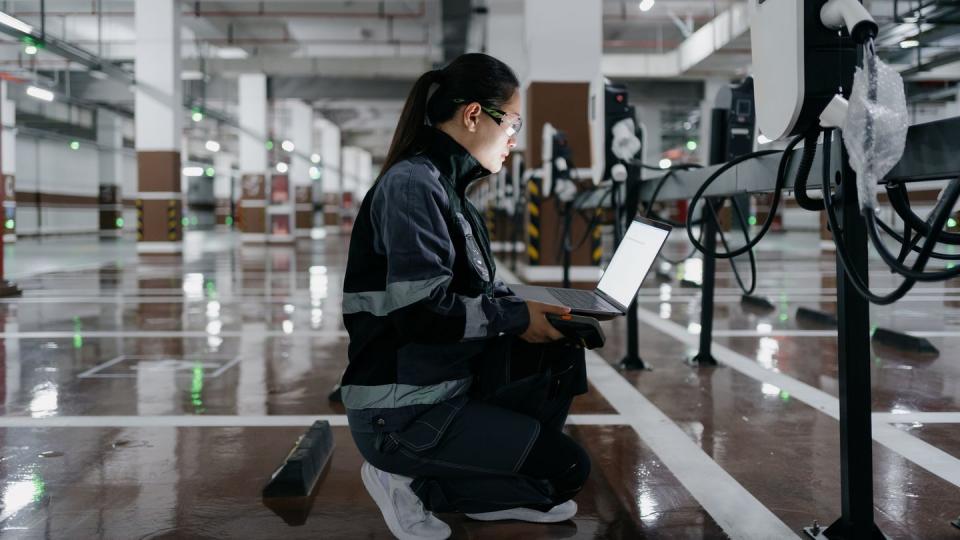Wanted: Trained Electricians to Keep EV Chargers Working

There were 1.2 million electricians identified by the 2000 US Census and just 610,000 in 2020. The US Bureau of Labor Statistics expects the labor pool of electricians to shrink 14% from 2023 to 2030.
Younger people entering the job market aren’t all that enthusiastic about the building trades—just 16.7% wanted work in construction, according to a high school and college survey.
“Plus, electricians figure into nearly every aspect of charging, from installing residential Level 2 units to DC fast-charge stations,” says EV mobility analyst Mike Austin.
In addition to the huge problem of non-working EV chargers, the push to electrification has another major issue: the lack of qualified journeymen electricians for residential and commercial installations.
According to Eric Feinberg, chief workforce officer at Qmerit, which connects installation companies and automakers with skilled electrical professionals, there were 1.2 million electricians identified by the 2000 US Census and just 610,000 in 2020.
Although the US Bureau of Labor Statistics (BLS) says the number had grown to 762,600 by 2022, the current trend is negative with retirements and other factors. BLS expects the labor pool of electricians to shrink 14% from 2023 to 2030. It’s currently shrinking 2% a year, says Qmerit.
The demand for new electricians is definitely growing. BLS reports, “About 73,500 openings for electricians are projected each year, on average, over the decade. Many of those openings are expected to result from the need to replace workers who transfer to different occupations or exit the labor force, such as to retire.”
According to BLS, “Employment of electricians is projected to grow 6% from 2022 to 2032, faster than the average for all occupations.”
Qmerit estimates that more than 142,000 new US electricians (over a 710,000 base) will be needed on the job by 2030 to meet the goals established by the Biden Administration, which wants half of all new cars sold by that year to be battery electric.
“A key factor is that, over the last 20 years, the majority of high school students gravitate to college, not blue-collar jobs,” Feinberg said. “What’s happened over the years is that demand for services is increasing with the electrification renaissance—but without enough trained electricians.”
Trends in the labor force point to the larger problem. Baby Boomers 55 and older are heading into retirement in larger numbers, says Pew Research. In the third quarter of 2020, Pew said, 28.6 million Baby Boomers (born between 1946 and 1964) retired, compared to 25.4 million who retired in the same quarter of 2019.
And younger people entering the job market aren’t all that enthusiastic about the building trades—just 16.7% wanted work in construction, according to a 2021 high school and college student survey cited in the Electrification Institute Electrification 2030 report, compared to 76.5% interested in working in technology.
Feinberg said that in California, there’s one journeyman for every 478 housing units. “And it’s not just EVs that cause the demand,” he said. “There’s also increased use of electric stoves, heat pumps, and solar integration.”
Mike Austin, senior research analyst for EVs and mobility at Guidehouse Insights, told Autoweek, “Yes, electricians are one layer of a very big onion. Any shortage compounds existing challenges like delays in regulatory approval and distribution upgrades.
“Plus, electricians figure into nearly every aspect of charging, from installing residential Level 2 units to DC fast-charge stations. I also think the maintenance aspect is under-appreciated. We don’t just need electricians to get more charging capacity installed—we’ll also need technicians to keep things running.”
The challenge is exacerbated by the higher voltage of today’s charging. “There’s more complexity to the installations,” Feinberg said. The problem is also serious on the commercial side, he added, as buildings are increasingly electrified.
Consumption of electricity nationwide is also growing. The same small labor pool of electricians that do the installations are also needed to fix the 4000 existing charging stations that are out of service across the country, according to the Energy Department.
It’s hard to get well-trained workers. Haig Nalbantian, co-founder of the Workforce Sciences Institute and a labor/organizational economist, told Autoweek the structure of the labor market contains “vast gaps and asymmetry of information that make it hard to tell if a hire is going to be a high-quality match.”
The hiring of people who aren’t a good fit leads to rapid terminations and what Nalbantian calls “quick quits” that, within the first two years of hiring, are very costly to employers, including electrical contractors. “The Qmerit solution is an all-in-one program to get electricians certified in their proficiencies, which means they can be counted on to do their jobs well in real time,” Nalbantian said.
Feinberg said training a journeyman electrician takes 8000 hours of hands-on training and between 250 and 500 hours of classroom training. “We’re currently not recognizing the demand generated by multiple electrical initiatives,” he said.
“Another issue is that we have states coming in and saying that charger installations have to be inspected and certified, which requires the right type of electrician. That’s a reason we’ve jump-started a program to vet entry-level electricians for contractors, who then pay for their apprenticeship training.”
Right now, any journeyman electrician will have no trouble getting hired. Matt Trout, president of Trout Electric in Southern California, told Automotive News, “If you came to me right now with a journeyman who’s been in the EV charging industry for the last couple of years, he’d be hired on the spot,” he said.
Do you think working as an electrician on EV chargers would be long-term stable work? Please comment below.

 Yahoo Autos
Yahoo Autos 